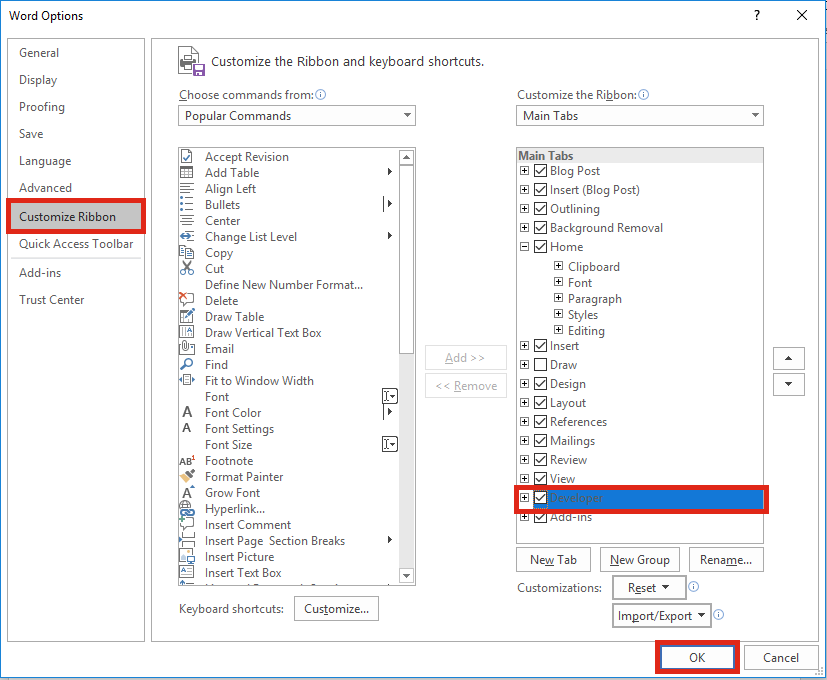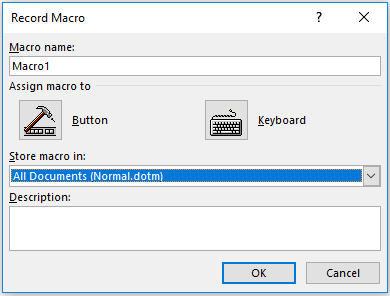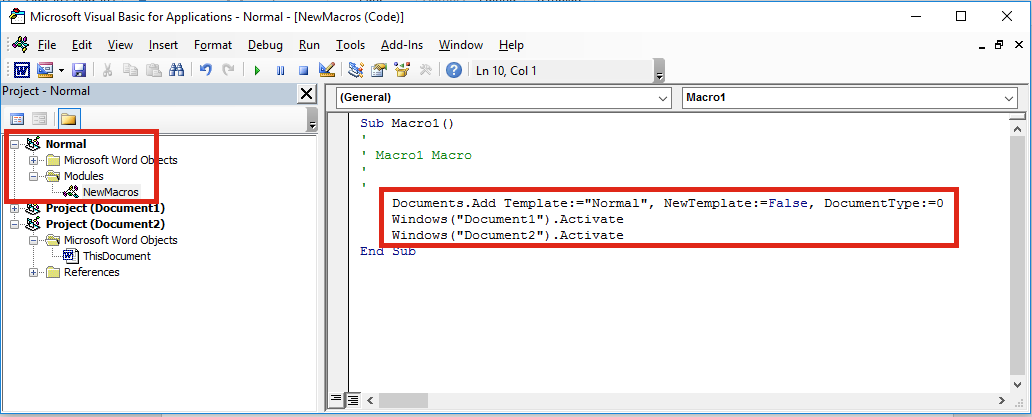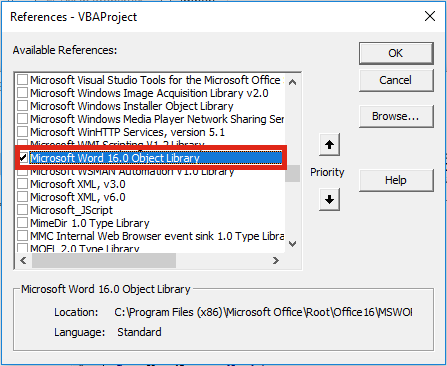I have two macros, one in Excel, and one in Word. The Excel Macro calls the Word macro. My code is as follows:
Excel:
Public wb1 As Workbook
Public dt1 As Document
Sub openword()
Dim wpath, epath As String 'where the word document will be opened and where the excel sheet will be saved
Dim wordapp As Object 'preparing to open word
Set wb1 = ThisWorkbook
While wb1.Sheets.Count <> 1
wb1.Sheets(2).Delete
Wend
wpath = "C:usersGPerryDesktopProjects and Workdocument.docm"
Set wordapp = CreateObject("Word.Application")
'Set wordapp = CreateObject(Shell("C:Program Files (x86)Microsoft OfficeOffice14WINWORD", vbNormalFocus)) this is one I tried to make work because while word.application seems to work, I don't *understand* it, so if anyone can help, that'd be awesome
wordapp.Visible = True
Set dt1 = wordapp.Documents.Open(wpath)
wordapp.Run "divider", wb1, dt1
dt1.Close
wordapp.Quit
End Sub
And word:
Sub divider(wb1, dt1)
Set dt1 = ThisDocument
If dt1.Paragraphs.Count > 65000 Then
Set cutrange = dt1.Range(dt1.Paragraphs(1).Range.Start, dt1.Paragraphs(65000).Range.End)
If wb1.Sheets(Sheets.Count).Cells(1, 1) <> "" Then
wb1.Sheets.Add After:=Sheets.Count
End If
Else
Set cutrange = dt1.Content
If wb1.Sheets(Sheets.Count).Cells(1, 1) <> "" Then
wb1.Sheets.Add After:=Sheets.Count
End If
End If
cutrange.Cut Destination:=wb1.Sheets(wb1.Sheets(Sheets.Count)).Cells(1, 1)
wb1.Sheets(Sheets.Count).Cells(1, 1).TextToColumns Destination:=wb1.Sheets(1).Cells(1, 1)
End Sub
My problem is that the variable wb1 isn’t getting passed between them. Even though I put wb1 in the list of variables to send to the macro, when it arrives at the document, wb1 has no value inside of it. I would re-initialize it, but I don’t know how to refer to an already existing document — only how to set it equal to one as you open it.
So either how do I pass the value through into the Word macro, or how do I re-initialize this variable? Preferably without having to set something equal to the excel application, because every time I try that it sets it equal to Excel 2003, not 2010 (though any solutions to that are also, of course, welcome).
Thanks!
-
#1
I am trying to call a word macro from in excel. If I ignore any variables, then it works. However, when I include any variables, it fails.
Public Sub doQuote()
‘Create the quote
Dim wdApp As Object
Dim wdDoc As Object
Set wdApp = CreateObject(«Word.Application»)
Set wdDoc = wdApp.Documents.Open(ThisWorkbook.Path & «NCR Form.dot»)
wdApp.Visible = True
‘This Works
wdApp.Run («test»)
‘These Fail (Object doesnt support this property)
wdApp.Run («test(«»Str»»)»)
wdApp.Run «test(«»Str»»)»
S = «str»
wdApp.Run («test(S)»)
wdApp.Run «test(S)»
‘This wont compile (.NET way of doing things)
wdApp.Run («test», «Str»)
Set wdApp = Nothing
Set wdDoc = Nothing
End Sub
Basically I’ve tried everything I can find and nothing seems to work as wanted. Any help would be awesome.
Thanks
Last edited: May 31, 2010
02-13-2006, 05:41 AM
#1
Call word from excel
Hello!
My macro doesn`t work, maybe anyone could help me???
I have to write a macro in Excel, that should open a Word document,
looking for a word (last month) and replace it with the actual month. (My code has problems with the selection and search)
Then it should replace numbers in the word document against numbers from my excel sheet.
Please help me!!!
[vba]
Sub Word()
Dim wdAnw As Object
Dim wdDok As ObjectApplication.ScreenUpdating = False
letztes_datum = InputBox(«Bitte geben sie das letzte Pr?fdatum ein, » & _
«damit der Monat durch den aktuellen Monat ersetzt » & _
«werden kann!», «letztes Pr?fdatum», 6250, 6150)
letzter_monat = Monat(letztes_datum)
akt_datum = Date
akt_monat = Monat(akt_datum)If letzter_monat = 1 Then
letzter_monat = «Januar»
ElseIf letzter_monat = 2 Then
letzter_monat = «Februar»
ElseIf letzter_monat = 3 Then
letzter_monat = «M?rz»
ElseIf letzter_monat = 4 Then
letzter_monat = «April»
ElseIf letzter_monat = 5 Then
letzter_monat = «Mai»
ElseIf letzter_monat = 6 Then
letzter_monat = «Juni»
ElseIf letzter_monat = 7 Then
letzter_monat = «Juli»
ElseIf letzter_monat = 8 Then
letzter_monat = «August»
ElseIf letzter_monat = 9 Then
letzter_monat = «September»
ElseIf letzter_monat = 10 Then
letzter_monat = «Oktober»
ElseIf letzter_monat = 11 Then
letzter_monat = «November»
ElseIf letzter_monat = 12 Then
letzter_monat = «Dezember»
End IfIf akt_monat = 1 Then
akt_monat = «Januar»
ElseIf akt_monat = 2 Then
akt_monat = «Februar»
ElseIf akt_monat = 3 Then
akt_monat = «M?rz»
ElseIf akt_monat = 4 Then
akt_monat = «April»
ElseIf akt_monat = 5 Then
akt_monat = «Mai»
ElseIf akt_monat = 6 Then
akt_monat = «Juni»
ElseIf akt_monat = 7 Then
akt_monat = «Juli»
ElseIf akt_monat = 8 Then
akt_monat = «August»
ElseIf akt_monat = 9 Then
akt_monat = «September»
ElseIf akt_monat = 10 Then
akt_monat = «Oktober»
ElseIf akt_monat = 11 Then
akt_monat = «November»
ElseIf akt_monat = 12 Then
akt_monat = «Dezember»
End IfApplication.ActivateMicrosoftApp xlMicrosoftWord
Const pfad = «M:Investment-ControllingprivatJudithMonatsreport_Performance_2006.doc»
Set wdDok = GetObject(pfad)
Set wdAnw = wdDok.Parent
wdAnw.Visible = True
wdAnw.WindowState = 1
wdDok.Activate….??????
Selection.Find.ClearFormatting ‘??
With Selection.Find
.Text = «Januar»
.Replacement.Text = «»
.Forward = True
.Wrap = wdFindContinue
.Format = False
.MatchCase = False
.MatchWholeWord = False
.MatchWildcards = False
.MatchSoundsLike = False
.MatchAllWordForms = False
End With
Selection.Find.Execute
With Selection.Find
.Text = «Januar»
.Replacement.Text = «Februar»
.Forward = True
.Wrap = wdFindContinue
.Format = False
.MatchCase = False
.MatchWholeWord = False
.MatchWildcards = False
.MatchSoundsLike = False
.MatchAllWordForms = False
End With
End SubFunction Monat(Datum)
Monat = Month(Datum)
End Function
[/vba]
Greetings, Judith
02-13-2006, 08:42 AM
#2
Judith
The way you have referred to the Selection I think will actually refer to the current selection in Excel, not Word.
02-13-2006, 09:49 PM
#3
[VBA]
Sub Word()
Dim wdAnw As Object
Dim wdDok As ObjectApplication.ScreenUpdating = False
letztes_datum = InputBox(«Bitte geben sie das letzte Pr?fdatum ein, » & _
«damit der Monat durch den aktuellen Monat ersetzt » & _
«werden kann!», «letztes Pr?fdatum», 6250, 6150)letzter_monat = Monat(letztes_datum)
akt_datum = Date
akt_monat = Monat(akt_datum)Select Case letzter_monat
Case 1: letzter_monat = «Januar»
Case 2: letzter_monat = «Februar»
Case 3: letzter_monat = «M?rz»
Case 4: letzter_monat = «April»
Case 5: letzter_monat = «Mai»
Case 6: letzter_monat = «Juni»
Case 7: letzter_monat = «Juli»
Case 8: letzter_monat = «August»
Case 9: letzter_monat = «September»
Case 10: letzter_monat = «Oktober»
Case 11: letzter_monat = «November»
Case 12: letzter_monat = «Dezember»
End SelectSelect Case akt_monat
Case 1: akt_monat = «Januar»
Case 2: akt_monat = «Februar»
Case 3: akt_monat = «M?rz»
Case 4: akt_monat = «April»
Case 5: akt_monat = «Mai»
Case 6: akt_monat = «Juni»
Case 7: akt_monat = «Juli»
Case 8: akt_monat = «August»
Case 9: akt_monat = «September»
Case 10: akt_monat = «Oktober»
Case 11: akt_monat = «November»
Case 12: akt_monat = «Dezember»
End SelectApplication.ActivateMicrosoftApp xlMicrosoftWord
Const pfad = «M:Investment-ControllingprivatJudithMonatsreport_Performance_2006.doc»
Set wdDok = GetObject(pfad)
Set wdAnw = wdDok.ParentwdAnw.Visible = True
wdAnw.WindowState = 1With wdDok
.Activate.Selection.Find.ClearFormatting ‘??
With .Selection.Find
.Text = «Januar»
.Replacement.Text = «»
.Forward = True
.Wrap = wdFindContinue
.Format = False
.MatchCase = False
.MatchWholeWord = False
.MatchWildcards = False
.MatchSoundsLike = False
.MatchAllWordForms = False
End With.Selection.Find.Execute
With .Selection.Find
.Text = «Januar»
.Replacement.Text = «Februar»
.Forward = True
.Wrap = wdFindContinue
.Format = False
.MatchCase = False
.MatchWholeWord = False
.MatchWildcards = False
.MatchSoundsLike = False
.MatchAllWordForms = False
End With
End WithSet wdDok = Nothing
Set wdAnw = Nothing
End SubFunction Monat(Datum)
Monat = Month(Datum)
End Function[/VBA]
02-14-2006, 12:06 AM
#4
Just an observation, we can get rid of a lot of lines of code.
All this code:
[vba]
If letzter_monat = 1 Then
letzter_monat = «Januar»
ElseIf letzter_monat = 2 Then letzter_monat = «Februar»
ElseIf letzter_monat = 3 Then
letzter_monat = «M?rz»
ElseIf letzter_monat = 4 Then
letzter_monat = «April»
ElseIf letzter_monat = 5 Then
letzter_monat = «Mai»
ElseIf letzter_monat = 6 Then
letzter_monat = «Juni»
ElseIf letzter_monat = 7 Then
letzter_monat = «Juli»
ElseIf letzter_monat = 8 Then
letzter_monat = «August»
ElseIf letzter_monat = 9 Then
letzter_monat = «September»
ElseIf letzter_monat = 10 Then
letzter_monat = «Oktober»
ElseIf letzter_monat = 11 Then
letzter_monat = «November»
ElseIf letzter_monat = 12 Then
letzter_monat = «Dezember»
End IfIf akt_monat = 1 Then
akt_monat = «Januar»
ElseIf akt_monat = 2 Then
akt_monat = «Februar»
ElseIf akt_monat = 3 Then
akt_monat = «M?rz»
ElseIf akt_monat = 4 Then
akt_monat = «April»
ElseIf akt_monat = 5 Then
akt_monat = «Mai»
ElseIf akt_monat = 6 Then
akt_monat = «Juni»
ElseIf akt_monat = 7 Then
akt_monat = «Juli»
ElseIf akt_monat = 8 Then
akt_monat = «August»
ElseIf akt_monat = 9 Then
akt_monat = «September»
ElseIf akt_monat = 10 Then
akt_monat = «Oktober»
ElseIf akt_monat = 11 Then
akt_monat = «November»
ElseIf akt_monat = 12 Then
akt_monat = «Dezember»
End If[/vba]
Can be replaced with this code:
[vba]
letzter_monat = Format(DateSerial(1, letzter_monat, 1), «mmmm»)
akt_monat = Format(DateSerial(1, akt_monat, 1), «mmmm»)
[/vba]I do not know if these functions are valid with the language version of Excel that you have (German?), but they should have an equivalent.
02-14-2006, 04:15 AM
#5
Good pickup Jake — I didn’t even think of it!
Call Word from Excel VBA — cannot CreateObject
Hi all. I’m trying to copy a range of cells into an existing word file. Here’s my code:
Sub test()
Range("A2", Cells(19, 7)).Copy
Dim WordApp As Object
Dim SaveDirectory As String
SaveDirectory = "C:UserstomDesktop"
Set WordApp = CreateObject("Word.Application")
With WordApp
'You can uncomment these 2 lines to see the process
' .Visible = True
' .Activate
.documents.Open ("C:UserstomDesktopcodecalendar.doc")
.Selection.EndKey Unit:=wdStory 'Move the insert point to the end of the .doc
.Selection.PasteAppendTable 'Paste in the table as "Merge Table"
.Selection.HomeKey Unit:=wdStory 'Move the insert point to the 1st row of the calendar,
.Selection.Rows.Delete 'Delte that empty row
.ActiveDocument.SaveAs2 Filename:=SaveDirectory + "Final semester calendar for " + "Fall 2019" + ".docx"
.ActiveDocument.Close 'Close the .doc generated
End With
End Sub
I am currently stuck on «Set WordApp = CreateObject(«Word.Application»)» and I just couldn’t pass through it. I kept getting the error of «Application-defined or object-defined error». I searched a lot but it seems like not too many people are calling Word from Excel so most posts are very old. I’m not sure whether I do it correctly since the tutorial I followed is also pretty old. Could someone help me with this problem? Thanks!
Edit: sorry I forgot to mention that I have the option for «Microsoft Word 16.0 Object Library» checked already.
2nd Edit: Solved the problem by myself. It turned out that if your word doc is a read-only document, you’d better use Set MyDoc = .Documents.Add rather than Set MyDoc = .Documents.Open. After that you can do the save as command.
See all How-To Articles
This tutorial demonstrates how to create a Word document from Excel or Google Sheets.
Link From Excel to Word Using Paste Options
- In the Excel file, select the required data. Then in the Ribbon, select Home > Clipboard > Copy.
- Open Word and create a new document. In the Ribbon, select Home > Clipboard > Paste > Link and Keep Source Formatting.
The selected Excel data is pasted into Word.
Insert Excel Content as an Object Into Word
- With a Word document open, in the Ribbon, select Insert > Text > Object.
- Select the Create from File tab.
Then use the Browse… button to select the Excel file to be inserted into Word as an object.
Finally, click OK to insert the object into the Word document.
The file contents are inserted into Word.
Paste Unformatted Data From Excel to Word
- In Excel, highlight the range of cells you need to copy to Word.
- In the Ribbon, select Home > Clipboard > Copy.
- Switch to an open Word document, or open Word and create a new document.
- In the Ribbon, select Home > Clipboard > Paste > Paste Special.
- Select Unformatted Unicode Text form the Paste option, and then click OK.
The data from Excel is pasted into Word as raw data (not in a table).
Create a Word Document From Google Sheets
You can copy and paste between a Google sheet and Word document the same way as in Excel.
- Select the range of cells in the Google sheet and press CTRL + C to copy the range of cells.
- Open Word and create a new document.
- In the Ribbon, select Home > Clipboard > Paste to paste the range of cells into Word as a table.
Alternatively, select Paste Special and select from the options that are provided.
You can’t use the Excel global objects from inside of Word without explicitly qualifying them (they simply don’t exist there). In particular, that means you can’t use Sheets. You should also explicitly declare the variable types of your parameters — otherwise they’ll be treated as Variant. This is important with reference types because in that it helps prevent run-time errors because the compiler knows that the Set keyword is required.
Sub divider(wb1 As Object, dt1 As Document)
Set dt1 = ThisDocument
If dt1.Paragraphs.Count > 65000 Then
Set cutrange = dt1.Range(dt1.Paragraphs(1).Range.Start, dt1.Paragraphs(65000).Range.End)
If wb1.Sheets(wb1.Sheets.Count).Cells(1, 1) <> "" Then
wb1.Sheets.Add After:=wb1.Sheets.Count
End If
Else
Set cutrange = dt1.Content
If wb1.Sheets(wb1.Sheets.Count).Cells(1, 1) <> "" Then
wb1.Sheets.Add After:=wb1.Sheets.Count
End If
End If
cutrange.Cut Destination:=wb1.Sheets(wb1.Sheets(wb1.Sheets.Count)).Cells(1, 1)
wb1.Sheets(wb1.Sheets.Count).Cells(1, 1).TextToColumns Destination:=wb1.Sheets(1).Cells(1, 1)
End Sub
Note — you also don’t need to pass dt1 at all. You never use the value in the parameter and actually set it to something else. This could be a source of errors if you’re using internal calls, because dt1 is implicitly passed ByRef (it gets boxed when you call it through Application.Run). That means whenever you call divider, whatever you pass to dt1 in the calling code will change to ThisDocument. You should either remove the parameter or specify that it is ByVal.
Хитрости »
24 Февраль 2012 91368 просмотров
Иногда бывает необходимо перенести что-то из Excel в другое приложение. Я возьму для примера Word. Например скопировать ячейки и вставить. Обычно мы это так и делаем — скопировали в Excel, открыли Word — вставили. Но сделать это при помощи кода чуть сложнее, хотя если разобраться никаких сложностей нет. Ниже приведен пример кода, который открывает Word, открывает в нем определенный документ, копирует данные из Excel и вставляет в открытый документ Word.
Sub OpenWord() Dim objWrdApp As Object, objWrdDoc As Object 'создаем новое приложение Word Set objWrdApp = CreateObject("Word.Application") 'Можно так же сделать приложение Word видимым. По умолчанию открывается в скрытом режиме 'objWrdApp.Visible = True 'открываем документ Word - документ "Doc1.doc" должен существовать Set objWrdDoc = objWrdApp.Documents.Open("C:Doc1.doc") 'Копируем из Excel диапазон "A1:A10" Range("A1:A10").Copy 'вставляем скопированные ячейки в Word - в начала документа objWrdDoc.Range(0).Paste 'закрываем документ Word с сохранением objWrdDoc.Close True ' False - без сохранения 'закрываем приложение Word - обязательно! objWrdApp.Quit 'очищаем переменные Word - обязательно! Set objWrdDoc = Nothing: Set objWrdApp = Nothing End Sub
Скачать пример:

В файле-примере, приложенном к данной статье, в комментариях к коду есть несколько добавлений. Например, как вставить текст из ячеек в определенные закладки Word-а и как добавить новый документ, а не открывать уже имеющийся. Так же так есть код проверки — открыто ли приложение Word в данный момент. Порой это тоже может пригодиться, чтобы работать с запущенным приложением Word, а не создавать новое:
Sub Check_OpenWord() Dim objWrdApp As Object On Error Resume Next 'пытаемся подключится к объекту Word Set objWrdApp = GetObject(, "Word.Application") If objWrdApp Is Nothing Then 'если приложение закрыто - создаем новый экземпляр Set objWrdApp = CreateObject("Word.Application") 'делаем приложение видимым. По умолчанию открывается в скрытом режиме objWrdApp.Visible = True Else 'приложение открыто - выдаем сообщение MsgBox "Приложение Word уже открыто", vbInformation, "Check_OpenWord" End If End Sub
В принципе, активировать или вызвать(если закрыто) другое приложение Офиса можно одной строкой:
Sub Open_AnotherApp() Application.ActivateMicrosoftApp xlMicrosoftWord End Sub
но данный метод может пригодиться только в том случае, если Вам необходимо действительно лишь активировать другое приложение, но дальше обращаться к этому приложению Вы уже не сможете.
По сути, методами CreateObject и GetObject можно обратиться к любому стороннему приложению(например Internet Explorer). Куда важнее при обращении к этим объектам знать объектную модель того приложения, к которому обращаетесь. Чтобы увидеть свойства и методы объектной модели приложения, можно в редакторе VBA подключить необходимую библиотеку, объявить переменную, назначив ей тип приложения. Покажу на примере того же Word-а.
Для начала открываем меню Tools -References:
Подключаем библиотеку:
Затем объявляем переменную и присваиваем ей тип нужного приложения:
Sub OpenWord() Dim objWrdApp As Word.Application Set objWrdApp = New Word.Application objWrdApp.Visible = True End Sub
Если теперь в редакторе, внутри этой процедуры в любом месте ниже объявления переменной набрать objWrdApp и точку, то сразу после ввода точки выпадет меню, в котором будут перечислены все доступные методы и свойства этого приложения.
Так же можно нажать F2 и через поиск найти Word и просмотреть все методы и свойства данного приложения.
Метод установки ссылки на библиотеку приложения через Tools—References называют еще ранним связыванием. Подобный метод позволяет создать ссылку на приложение быстрее и, как описано выше, предоставляет разработчику доступ к визуальному отображению свойств и методов объекта. Но есть существенный минус: если в своем коде Вы установите ссылку на Word 12 Object Libbary(Word 2007), то на ПК с установленным Word 2003 получите ошибку MISSING, т.к. Word 2003 относится к библиотеке Word 11 Object Libbary. Подробнее можно прочитать в статье Ошибка — Cant find project or library.
Метод же CreateObject еще называется методом позднего связывания. Применяя его не возникнет проблем с MISSING, очень часто возникающих при раннем связывании. Поэтому я рекомендовал бы при разработке использовать раннее связывание для удобства использования свойств и методов(если Вы их не знаете), а перед распространением приложения в коде заменить все именованные константы(типа wdLine) на числовые константы(для wdLine это 5) и применить позднее связывание. Посмотреть числовое значение константы можно просто записав её в коде, начать выполнение кода через F8 и навести курсор мыши на эту константу. Всплывающая подсказка покажет числовое значение. Так же можно отобразить окно Immediate(View —Immediate Window или сочетание клавиш Ctrl+G), записать вопросительный знак и вставить эту константу и нажать Enter:
?wdLine
ниже будет выведено числовое представление этой константы.
А заменять эти константы их числовыми значениями в случае с поздним связыванием необходимо, т.к. Excel не знает их значений.
Попробую пояснить поподробнее про эти константы и почему их надо заменять какими-то числами: при подключении библиотеки Wordа(Word 12 Object Libbary) мы так же подключаем и все свойства, методы и константы, которые доступны из Wordа. И их использование напрямую становится доступно из Excel и мы можем смело написать что-то вроде wbLine и Excel поймет эту константу. При позднем же связывании мы уже не подключаем библиотеки Word(во избежание ошибок совместимости) и как следствие — методы, свойства и константы Wordа для Excel становятся чем-то неизвестным и не документированным и мы получим ошибку «Variable not defined»(если включена директива Option Explicit) при попытке назначить свойство через wdLine. Если же Option Explicit не включена — то хоть ошибки не будет, но и код будет работать неверно, т.к. для неизвестной для Excel переменной wbLine будет назначено значение 0(Empty). Поэтому и надо все константы другого приложения заменять их числовыми значениями.
Главная ошибка новичка
И хочу так же упомянуть про ошибку, которую очень часто совершают при обращении к одному приложению из другого. Допустим, необходимо скопировать из Word все данные в Excel. Часто начинающие делают это так:
Sub OpenWord() Dim objWrdApp As Object, objWrdDoc As Object 'создаем новое приложение Word Set objWrdApp = CreateObject("Word.Application") 'Можно так же сделать приложение Word видимым. По умолчанию открывается в скрытом режиме 'objWrdApp.Visible = True 'открываем документ Word - документ "Doc1.doc" должен существовать Set objWrdDoc = objWrdApp.Documents.Open("C:Doc1.doc") 'Копируем из Word все данные, обращаясь к объекту Range документа Range.Copy 'вставляем скопированное в ячейку А1 активного листа Excel ActiveSheet.Paste 'закрываем документ Word без сохранения objWrdDoc.Close False 'закрываем приложение Word objWrdApp.Quit 'очищаем переменные Word - обязательно! Set objWrdDoc = Nothing: Set objWrdApp = Nothing End Sub
На строке Range.Copy обязательно получите ошибку от VBA, указывающую, что нужен аргумент для объекта. Можно попробовать добавить этот аргумент: Range(1).Copy. Но все равно получим ошибку. Можно, конечно, указать даже ячейки: Range(«A1»).Copy. Но это приведет к тому, что скопирована будет ячейка А1 активного листа Excel.
Все дело в том, что мы хотим скопировать данные из Word-а, выполняя при этом код из Excel. А у Excel тоже есть объект Range с другими аргументами. И если не указать какому приложению, листу или документу принадлежит Range, то по умолчанию он будет отнесен к тому приложению, из которого выполняется код. Т.е. к Excel. Если совсем кратко об этом — всегда надо указывать какому приложению или объекту принадлежит используемый объект или свойство. Правильно код должен выглядеть так:
Sub OpenWord() Dim objWrdApp As Object, objWrdDoc As Object 'создаем новое приложение Word Set objWrdApp = CreateObject("Word.Application") 'Можно так же сделать приложение Word видимым. По умолчанию открывается в скрытом режиме 'objWrdApp.Visible = True 'открываем документ Word - документ "Doc1.doc" должен существовать Set objWrdDoc = objWrdApp.Documents.Open("C:Doc1.doc") 'Копируем из Word все данные, обращаясь к объекту Range документа 'при этом перед Range явно указываем откуда его брать - из документа Word -objWrdDoc("C:Doc1.doc") objWrdDoc.Range.Copy 'вставляем скопированное из Word в активную ячейку активного листа Excel ActiveSheet.Paste 'закрываем документ Word без сохранения objWrdDoc.Close False 'закрываем приложение Word objWrdApp.Quit 'очищаем переменные Word - обязательно! Set objWrdDoc = Nothing: Set objWrdApp = Nothing End Sub
Вместо Range ту же ошибку делают и с Selection(потому что Selection часто присутствует в записанных макрорекордером макросах), т.к. этот объект есть и в Excel и в Word и без явного указания приложения будет относится к приложению, в котором записано.
В приложенном файле код немного отличается от представленных выше — в нем можно посмотреть как вставить текст из ячеек в определенные(созданные заранее) закладки Word-а. Это удобно для создания бланков в Word и заполнения их через Excel
Скачать пример:

А в архиве ниже — практически готовое решение заполнения всевозможных бланков Word из Excel. Как это работает. У нас есть таблица Excel с данными для заполнения бланков заявлений на пособия:
Обращаю внимание, что в первой строке расположены метки. Они нужны для того, чтобы код мог понять значения какого столбца в какое место шаблона Word должны попасть. А в самом шаблоне Word мы должны проставить эти самые метки:
Фигурные скобки сделаны для того, чтобы код 100% искал и заменял только метку в шаблоне, исключая при этом замену случайного текста вне скобок(ведь слово «Должность» может встречаться и само по себе).
А здесь я схематично привел то, как будут происходить замены:
Сначала программа создаст новую папку, в которую и будет сохранять создаваемые файлы(имя папки состоит из даты и времени запуска кода). Далее программа циклом пройдется по каждой строке таблицы, создаст на основании шаблона Word(«Шаблон.doc») новый файл для этой строки, заполнит этот шаблона данными на основании меток, и сохранит созданный файл под новым именем. Сам файл шаблона при этом не изменяется — все метки в нем сохраняются как были настроены до запуска кода. Конкретно в приложенном коде значение для имени нового файла берется из первого столбца «ФИО с инициалами». Но это можно изменить в коде при необходимости. Делается это в этой строке:
'считываем фамилию с инициалами
sWDDocName = .Cells(lr, 1).Value
Что еще важно: файл шаблона Word должен находиться в той же папке, что и файл с кодом. Название файла в приложенном к статье файле должно быть «Шаблон.doc». Но его так же можно изменить, не забыв изменив его в коде в этой строке:
'имя шаблона Word с основным текстом и метками Const sWDTmpl As String = "Шаблон.doc"
В общем-то, если хоть чуть-чуть разбираетесь, то поменять можно многое. А для тех, кто не разбирается достаточно будет просто создавать метки в файле Word и обозначать ими столбца в таблице Excel. Количество столбцов и строк в таблице код определяет автоматически и при изменении размеров таблицы ничего изменять не надо. Главное, чтобы метки находились в первой строке, вторая строка — заголовок(необязательно), а с третьей строки начинаются данные, которые и используются для наполнения шаблонов.
Скачать пример:

Примеры работы с тем же Outlook можно посмотреть в моих статьях:
Как отправить письмо из Excel?
Сохранить вложения из Outlook в указанную папку
Статья помогла? Поделись ссылкой с друзьями!
Видеоуроки
Поиск по меткам
Access
apple watch
Multex
Power Query и Power BI
VBA управление кодами
Бесплатные надстройки
Дата и время
Записки
ИП
Надстройки
Печать
Политика Конфиденциальности
Почта
Программы
Работа с приложениями
Разработка приложений
Росстат
Тренинги и вебинары
Финансовые
Форматирование
Функции Excel
акции MulTEx
ссылки
статистика
INTELLIGENT WORK FORUMS
FOR COMPUTER PROFESSIONALS
Contact US
Thanks. We have received your request and will respond promptly.
Log In
Come Join Us!
Are you a
Computer / IT professional?
Join Tek-Tips Forums!
- Talk With Other Members
- Be Notified Of Responses
To Your Posts - Keyword Search
- One-Click Access To Your
Favorite Forums - Automated Signatures
On Your Posts - Best Of All, It’s Free!
*Tek-Tips’s functionality depends on members receiving e-mail. By joining you are opting in to receive e-mail.
Posting Guidelines
Promoting, selling, recruiting, coursework and thesis posting is forbidden.
Students Click Here
How do I call a word macro from excel?How do I call a word macro from excel?(OP) 18 Dec 03 11:49 How do I call a word macro from excel? thanks, Red Flag SubmittedThank you for helping keep Tek-Tips Forums free from inappropriate posts. |
Join Tek-Tips® Today!
Join your peers on the Internet’s largest technical computer professional community.
It’s easy to join and it’s free.
Here’s Why Members Love Tek-Tips Forums:
Talk To Other Members
- Notification Of Responses To Questions
- Favorite Forums One Click Access
- Keyword Search Of All Posts, And More…
Register now while it’s still free!
Already a member? Close this window and log in.
Join Us Close
-
03-19-2009, 03:58 PM
#1
Registered User
Calling word from excel
Hello,
The code below basically copies files with an .mht extension to a temp directory then opens those files from the temp directory in word and saves them as a .html extension. I have all my references set and this process works fine until it gets about half way through the save as .html process. There error message I get is vaugue: «Error 91: Object variable or With Block variable not set». Does anyone see anything incorrect with my code? Since this process works up until some point, I can’t determine what the issue is.
-
03-19-2009, 04:07 PM
#2
Re: Calling word from excel
Entia non sunt multiplicanda sine necessitate
-
03-19-2009, 04:12 PM
#3
Re: Calling word from excel
Hello gnome_core,
You didn’t use the Set statement to free the objects you declared.
It should be this…
Sincerely,
Leith RossRemember To Do the Following….
1. Use code tags. Place [CODE] before the first line of code and [/CODE] after the last line of code.
2. Thank those who have helped you by clicking the Star
below the post.
3. Please mark your post [SOLVED] if it has been answered satisfactorily.
Old Scottish Proverb…
Luathaid gu deanamh maille! (Rushing causes delays!)
-
03-19-2009, 04:25 PM
#4
Re: Calling word from excel
Aside from that (and there’s no need to do it; they are set to Nothing when they go out of scope), you mifght want to make sure you’re not trying to loop through an empty collection:
Last edited by shg; 03-19-2009 at 04:28 PM.
-
03-19-2009, 04:44 PM
#5
Re: Calling word from excel
Hello Shg,
When objects are late bound, the memory allocated to the object is not released automatically when it goes out of scope. There are a few exceptions to the rule, like the Dictionary object.
Error 91 is generated by attempting to assign an object without using the Set statement. So removing the statements will stop the error, but does not address the cause.
-
03-19-2009, 04:54 PM
#6
Re: Calling word from excel
I changed them to early bound.
-
03-20-2009, 11:19 AM
#7
Registered User
Re: Calling word from excel
Thank you both. That has resolved that issue. However, a new one is happening. The error message is: «Error 5180: Method ‘open’ of object ‘Documents’ failed. This occurs on the line:
And it always happens on the 60th file to open. So everything works as intended until it gets to the 60th file to open. I verified it is not the actual file as I’ve tried this with may different files in the folder. Is there some restriction on the number of word docs you can cycle through in a procedure? Really doesn’t make much sense to me.
Thanks again,
J
-
03-20-2009, 11:36 AM
#8
Re: Calling word from excel
-
03-20-2009, 12:53 PM
#9
Registered User
[Solved] Re: Calling word from excel
Once I set this:
everything worked. I was able to process all 170 files in the dir.
I updated my code to use this new logic:
Thanks for all the help!
Last edited by gnome_core; 03-20-2009 at 01:13 PM.
-
03-20-2009, 12:57 PM
#10
Re: Calling word from excel
Glad you got it sorted out, and thanks for posting back with the solution. I don’t do any Word automation, and so couldn’t contribute much.
Would you please mark the thread as Solved?
Click the Edit button on your first post in the thread
Click Go Advanced, select [SOLVED] from the Prefix dropdown, then click Save Changes
This post is the second in a series about controlling other applications from Excel using VBA. In the first part we looked at the basics of how to reference other applications using Early Binding or Late Binding. In this post, we will look at how we can automate Word from Excel even though we don’t know any VBA code for Word… yet. The process we will use for this is as follows:
- Enable the Word Developer menu
- Record a Word macro
- Add the code to Excel VBA and amend
- Record macros in Excel if necessary
- Repeat the previous steps until macro complete
I am not an Excel VBA expert (I’m more of an Excel VBA tinkerer), and I am certainly not a Word VBA expert. The process I am about to show you may not create the most efficient code, but I know this process works, because I have used it myself to automate lots tasks using Microsoft Word.
Enable the Word Developer menu
If you have enabled the Excel Developer menu it is the same process in Word.
In Word: File -> Options -> Customize Ribbon
Then tick the Developer Ribbon option, OK.
Record a Word Macro
The key to the success of this method is taking small sections of code and building up a complex macro bit by bit. Using the Word Macro Recorder is again, similar to the Excel Macro recorder.
Click on: Developer -> Record Macro
For the example in this post, we will create a macro which will open a new Word document, then copy a chart from Excel and paste it into that Word document. We will tackle this one stage at a time. Firstly, lets create the macro to open a new word document.
Click – Developer -> Record Macro. The Record Macro window will open.
Make a note of the “Store macro in” option, as we will need to know where to find the recorded code later. Normal.dotm is fine for now. Click OK – the Macro Recorder is now running.
Open a new Word Document – File -> New -> Blank Document
Stop the Macro from recording – Developer -> Stop Recording
We can now view the code for opening a new Word Document in the Visual Basic Editor. Click: Developer -> Visual Basic.
Find the location of your recorded code in the Visual Basic Editor. In this example: Normal -> Modules -> NewMacros.
Your code should look like the following. It may be slightly different, but not significantly.
Sub Macro1() ' ' Macro1 Macro ' ' Documents.Add Template:="Normal", NewTemplate:=False, DocumentType:=0 Windows("Document1").Activate Windows("Document2").Activate End Sub
Add the code to Excel VBA and amend
Let’s head back to the Excel VBA Editor and use the Early Binding method to control to Microsoft Word. In the Visual Basic Editor click Tools -> References select Microsoft Word x.xx Object Library. Then click OK.
As we are using Early Binding we need to declare the Application as a variable as follows:
Dim WordApp As Word.Application Set WordApp = New Word.Application
Now copy and paste the code from the Word VBA Editor into the Excel VBA Editor.
The Word VBA code started with Documents.Add, all we have to do is add our application variable to the front of that line of code. Now becomes WordApp.Documents.Add . . .
Often, Selecting and Activating Objects is not required in VBA code, so I have not copied those statements into the code below.
Sub CreateWordDocument() 'Connect using Early Binding. 'Remember to set the reference to the Word Object Library 'In VBE Editor Tools -> References -> Microsoft Word x.xx Object Library Dim WordApp As Word.Application Set WordApp = New Word.Application WordApp.Documents.Add Template:="Normal", NewTemplate:=False, DocumentType:=0 WordApp.Visible = True 'New Apps will be hidden by default, so make visible Set WordApp = Nothing 'release the memory End Sub
A point to note, when an application is opened with VBA, it is normally opened in the background. To make the Word document visible I have added the following code:
WordApp.Visible = True
Record macros in Excel (if necessary)
If we want to copy Excel content into a Word document, we will need to copy that content using Excel VBA. We can use the Macro Recorder in Excel to obtain the VBA code for copying, then we can use the Word Macro Recorder to obtain the VBA code for pasting.
Macro Recording from Excel – selecting a worksheet and copying chart
Sheets("Sheet1").Select
ActiveSheet.ChartObjects("Chart 1").Activate
ActiveChart.ChartArea.Copy
Macro Recording from Word – pasting a chart into a document
Selection.PasteSpecial Link:=False, DataType:=wdPasteEnhancedMetafile, _ Placement:=wdInLine, DisplayAsIcon:=False
We can add both Macro recordings into our Excel macro. Remember to add WordApp. at the start of each statement of Word VBA code.
Sub CreateWordDocument() 'Connect using Early Binding. 'Remember to set the reference to the Word Object Library 'In VBE Editor Tools -> References -> Microsoft Word x.xx Object Library Dim WordApp As Word.Application Set WordApp = New Word.Application WordApp.Documents.Add Template:="Normal", NewTemplate:=False, DocumentType:=0 WordApp.Visible = True 'New Apps will be hidden by default, so make visible 'code copied from Excel Macro recorder Sheets("Sheet1").Select Selection.ChartObjects("Chart 1").ChartArea.Copy 'code copied from Word Macro recorder with WordApp. added to the front. WordApp.Selection.PasteSpecial Link:=False, DataType:=wdPasteEnhancedMetafile, _ Placement:=wdInLine, DisplayAsIcon:=False Set WordApp = Nothing 'release the memory End Sub
This code is not particularly efficient; it contains a few unnecessary sections code. However… it works!
Repeat the previous steps until macro complete
By repeating the same steps above; recording short actions, then transferring the code into Excel, we can slowly build up much more complex Macros. The key is to keep the actions short, if you do too many actions with the Macro Recorder, code starts to look long and scary.
If you’ve you tried to use the Macro Recorder before you will know that this is not as easy as it seems. And this simple tutorial may make you think it is easy, when it’s not. Sometimes, it can be quite frustrating trying to find out where the issues and errors are. The key to success is recording very short actions, such as those below and copying them into the Visual Basic Editor.
'Pressing the Enter Key to move to a new line in Word WordApp.Selection.TypeParagraph 'Turn on/off Bold Text WordApp.Selection.Font.Bold = wdToggle 'Change Font Size WordApp.Selection.Font.Size = 16 'Type some text WordApp.Selection.TypeText Text:="Here is some text"
You will soon build up a standard library of code that you can use to control Word for most basic tasks.
In recorded VBA code from Word, the word “Selection” in the code often refers to the document itself. It is possible to make the code a little bit more efficient by declaring the document as a variable. If we were opening a specific document, we could include this at the start, just below the declaration of the application.
'Declare a specific document as a variable Dim WordDocument As Object Set WordDocument = WordApp.Documents.Open(sourceFileName)
Or, if we created a new document we could include the following below the declaration of the application variable.
'Delcare a new document as a variable Dim WordDocument As Object Set WordDocument = WordApp.Documents.Add Template:="Normal", _ NewTemplate:=False, DocumentType:=0
If we have created the document as a variable we can then reference the specific document. This code:
WordApp.Selection.TypeParagraph
Would become this code:
WordDocument.TypeParagraph
Or this code:
WordApp.Selection.TypeText Text:="Here is some text"
Would become this code:
WordDocument.TypeText Text:="Here is some text"
This method is much better, as it doesn’t rely on the Selection of the user being in the right place.
Conclusion
We have seen in this post that it is possible to create complex Macros to automate Word from Excel using VBA. By understanding how to declare variables for the application and documents we can create much more robust macros, even without knowing a lot of VBA code.
Related Posts:
- 5 quick ways to embed a Word document in Excel
- Controlling Powerpoint from Excel using VBA
- Edit links in Word using VBA
- How to link Excel to Word
About the author
Hey, I’m Mark, and I run Excel Off The Grid.
My parents tell me that at the age of 7 I declared I was going to become a qualified accountant. I was either psychic or had no imagination, as that is exactly what happened. However, it wasn’t until I was 35 that my journey really began.
In 2015, I started a new job, for which I was regularly working after 10pm. As a result, I rarely saw my children during the week. So, I started searching for the secrets to automating Excel. I discovered that by building a small number of simple tools, I could combine them together in different ways to automate nearly all my regular tasks. This meant I could work less hours (and I got pay raises!). Today, I teach these techniques to other professionals in our training program so they too can spend less time at work (and more time with their children and doing the things they love).
Do you need help adapting this post to your needs?
I’m guessing the examples in this post don’t exactly match your situation. We all use Excel differently, so it’s impossible to write a post that will meet everybody’s needs. By taking the time to understand the techniques and principles in this post (and elsewhere on this site), you should be able to adapt it to your needs.
But, if you’re still struggling you should:
- Read other blogs, or watch YouTube videos on the same topic. You will benefit much more by discovering your own solutions.
- Ask the ‘Excel Ninja’ in your office. It’s amazing what things other people know.
- Ask a question in a forum like Mr Excel, or the Microsoft Answers Community. Remember, the people on these forums are generally giving their time for free. So take care to craft your question, make sure it’s clear and concise. List all the things you’ve tried, and provide screenshots, code segments and example workbooks.
- Use Excel Rescue, who are my consultancy partner. They help by providing solutions to smaller Excel problems.
What next?
Don’t go yet, there is plenty more to learn on Excel Off The Grid. Check out the latest posts:


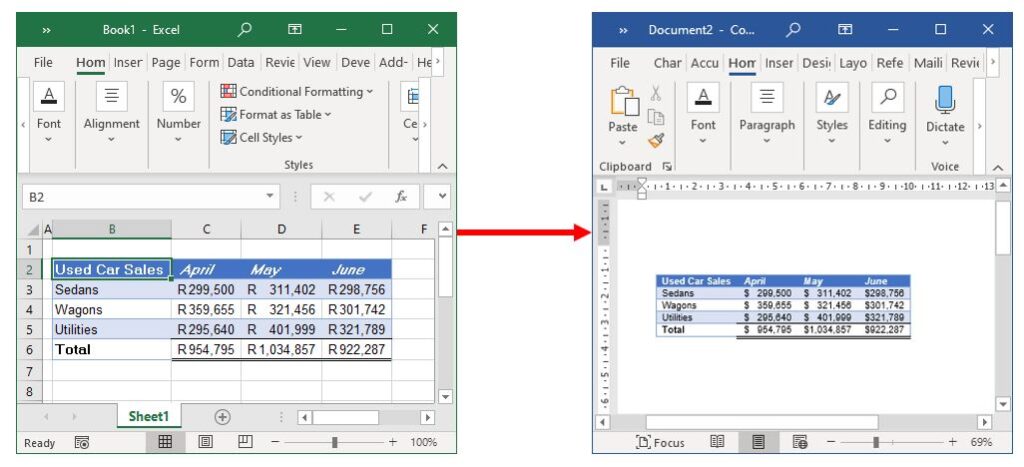
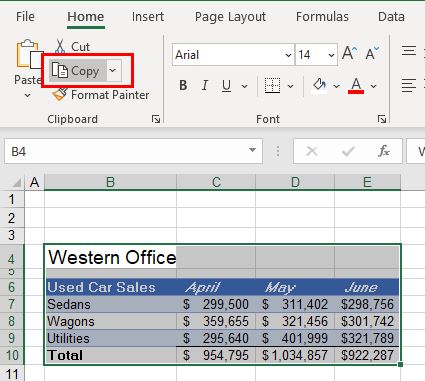
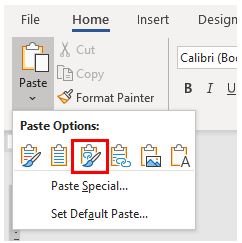
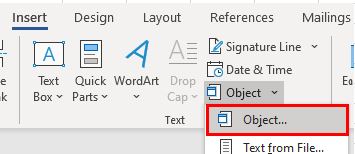
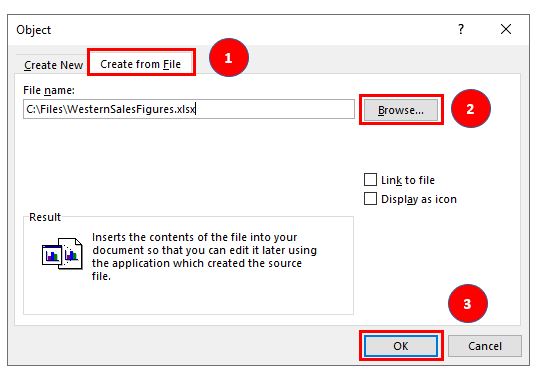
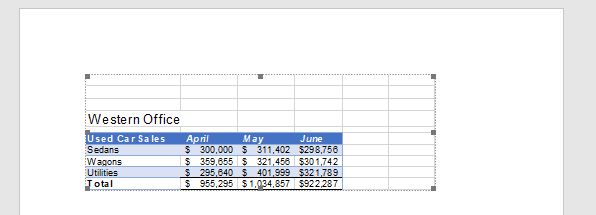
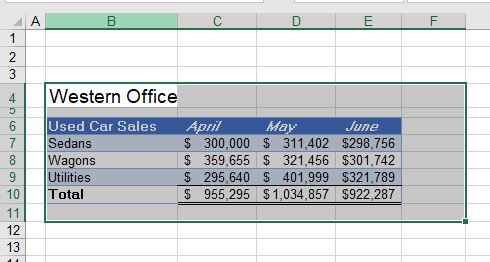
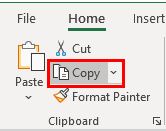
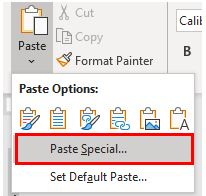
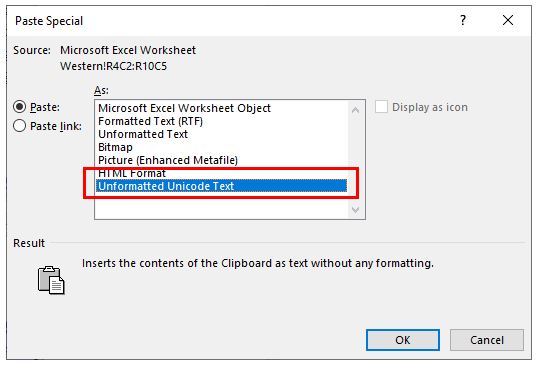
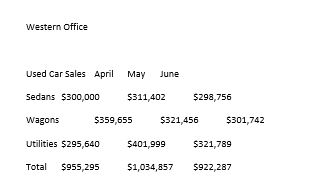
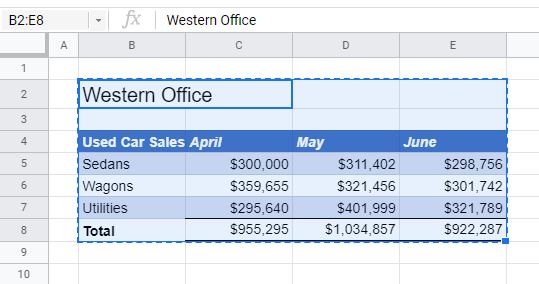
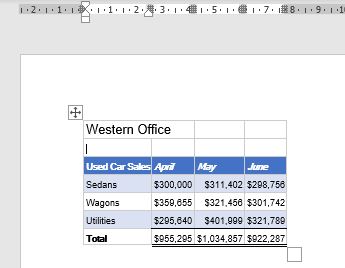
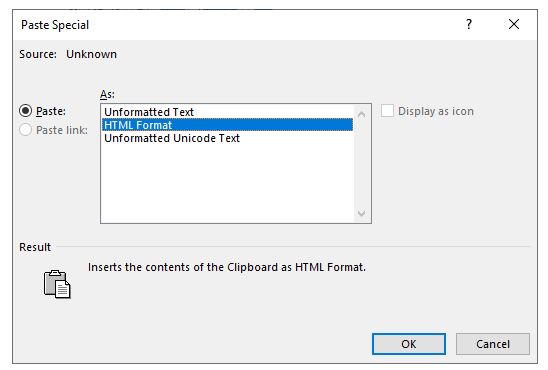


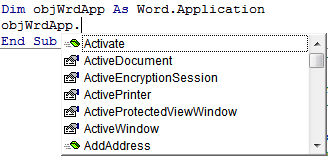



 Talk To Other Members
Talk To Other Members
